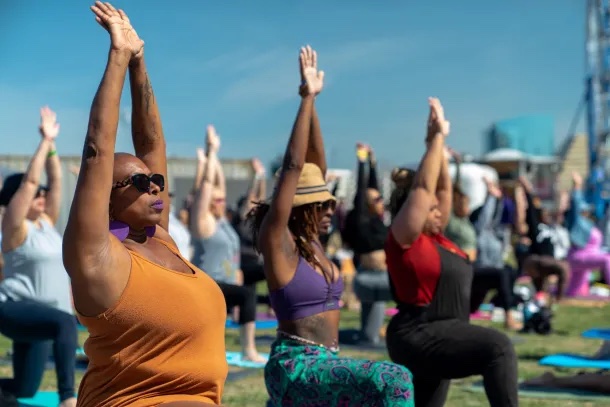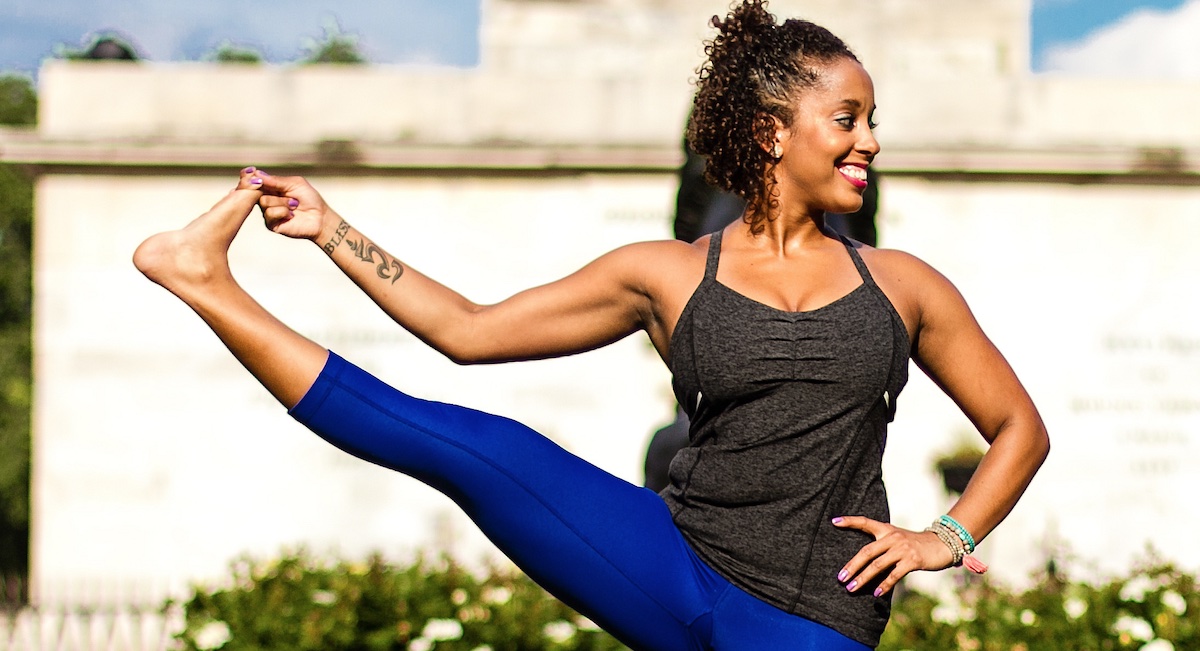Editor’s Note: Below is a short snippet of a feature article by the Sacramento Observer titled “The 8 Limbs of the Black Yogi,” an in-depth portrait of the growing community of Black yoga practitioners in and around Sacramento, California. Read the full story at the Sacramento Observer. (Image via Wikimedia)
By Jared D. Childress | OBSERVER Staff Writer
First impressions are everything. At first, Kirsten Johnson didn’t like yoga.
A doctor said it would help mitigate her arthritis and spinal issues, so she dropped into a class at a big box gym in Rosemont, Sacramento – but it wasn’t what she’d hoped. Instead of feeling better, she left in more pain. The yoga instructor wasn’t very helpful, leaving the then 46-year-old to contort herself into positions not suited for her differently abled body.
That class could have been the end of Johnson’s yoga journey. But, at the insistence of a friend, she went back for a second class.
This time, she had a much different experience. With a much different teacher.
“This teacher was what I needed at the time. She came up to everybody and welcomed them. And not only did she say hello but she knew them. That really got me and I stayed in that class,” Johnson said. “And there were more people like me in this class. There were older people, Black people – all types of people.”
That single positive experience in 2012 grew to a regular practice culminating with her completing a 200-hour teacher training, becoming a certified yoga instructor in 2017. Today, the 57-year-old is the president of Yoga Moves Us, a non-profit which offers free community yoga classes in the Sacramento area.
“Community yoga changed my life and I really wanted to give that opportunity to everybody I knew,” Johnson said. “But I know that for Black, brown and marginalized people, yoga is not accessible. It’s expensive… So my mission is to make it accessible, inviting and inclusive for everybody.”

Yoga is a multi-billion dollar global industry estimated at $37.46 billion in 2019 and projected to reach $66.23 billion by 2027. In the United States alone, it rakes in $9 million annually with the average yogi spending $1,080 a year toward their practice.
More than 36 million Americans practice yoga, but the largest consumers are by-in-large affluent white women. In 2002, 85% of yogi’s identified as white and 70% were female.
Over the last two decades, Blacks participation in yoga has seen a slight incline. It climbed from 2.5 percent in 2002 to 9.3 percent in 2017, according to National Health Interview Survey data. Additionally, Blacks make up 5.7% of yoga instructors.
While it may seem fitting that the face of this lucrative business remains wafer-thin white women bent into pretzel-like shapes on yoga magazines, there’s more to it than phenotype, fitness, and finances.
Yoga means “to become one with” and is derived from the Sanskrit word “to yoke.” And the ancient spiritual practice began in communities of color. Its origins are often traced to northern India 5,000 years ago, but what is lesser known is that it also has roots in Africa.
Angie Franklin is a Sacramentan who practices Kemetic Yoga. This system of yoga was developed in the 1970s and is based on ancient Egyptian yoga postures said to predate Indian origins. Franklin continues this ancient practice as founder and CEO of Afro Yoga, a wellness movement that is revolutionizing the industry.
“There’s a gap in understanding that we actually come from these practices — these practices are in our DNA,” said Franklin, 36. “The marketing we’ve seen and the colonial mindset has co-opted it to the point where the can actually feel disconnected from the practice that was theirs to begin with, which is wild to think about.”
But Blacks don’t have to look to ancient history to see themselves in yoga. In more recent history, yoga was used by Black leaders as a tool for liberation. Rosa Parks practiced yoga alongside her niece and nephew in the 1960s; the Black Panther Party instituted meditation and mindfulness at the Oakland Community School; and Angela Davis practiced handstands in prison to relieve migraines.
Much like Black history, a lot of yoga’s history is passed on through the oral tradition. But one of the first to put the tenets of yoga in writing was Patanjali, an Indian sage who in 400 C.E. codified the “8 Limbs of Yoga.”
The 8 Limbs of Yoga are aspects of the ancient discipline that promote spiritual growth. While understanding the sanskrit words can be difficult, they can best be seen in how yogis live their lives on and off the mat.
The OBSERVER visited Black yogis in the Sacramento area to learn how these eight aspects manifest in their daily lives. While some came to yoga on the heels of incarceration, others came by way of a high school class, and some stumbled upon a gym class. All have an individual experience with the daily spiritual practice.
Read the rest of the story at The Sacramento Observer




